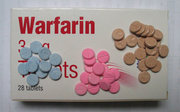Stroke survivors taking the widely prescribed blood thinner warfarin (brand name: Coumadin) had more than twice the rate of death, brain hemorrhage, and heart attack than the people on high doses of aspirin. These findings from a clinical trial conducted at 59 North American academic medical centers was published recently in The New England Journal of Medicine. Did stroke specialists around the country call each of their stroke patients to tell them to come in immediately? Not likely. The more typical scenario would be to wait for the patient to come in again and then talk about changing the prescription.
But this trial, known as the Warfarin-Aspirin Symptomatic Intracranial Disease Trial, clearly showed that warfarin is overwhelmingly the wrong treatment even for extremely high-risk people. The 569 study participants had been randomly assigned to take daily doses of warfarin or 1300 mg aspirin. They had either suffered a transient ischemic attack or a major stroke. The standard scans and imaging tests given to people after a stroke showed that most of the participants had severe constrictions of a key intracranial artery. The research team led by Dr. Marc I. Chimowitz, Department of Neurology, Emory University, found high-dose aspirin to be the much safer treatment. Here are the adverse reaction rates for each treatment group after 20 months:
A major hemorrhage, which occurred in 8% of the people on warfarin, was defined as a hemorrhage that necessitates hospitalization, transfusion, or surgery. Not surprisingly, Dr. Chimowitz and colleagues concluded that aspirin is the preferred treatment even for people with severe constrictions of a cranial artery. "Warfarin was associated with significantly higher rates of adverse events and provided no benefit over aspirin in this trial."
To explain why this trial was necessary, Dr. Chimowitz and colleagues wrote that there was a great deal of uncertainty among stroke specialists (neurologists) about the appropriate treatment for people with severely constricted cranial arteries. This was illustrated in a recent survey that showed half the neurologists preferred antiplatelet therapy (aspirin, Plavix, etc.) and half preferred warfarin. This clinical trial has clearly identified the preferred drug, but uncertainty remains about the optimal dose. It is possible, for example, that the 1300 mg daily dose of aspirin taken by half the participants in this trial is unnecessarily high.
Only 63% Maintained at Correct Dose
Another interesting aspect of this trial relates to the fact that warfarin has a "narrow therapeutic range." The drug interacts with so many foods, herbs, and other drugs that doctors typically have a difficult time keeping their patients within the correct narrow dose range. The Warfarin-Aspirin Symptomatic Intracranial Disease Trial investigators did not fare much better. Only 63% of the study participants on warfarin therapy were maintained at the proper blood levels.
Another alarming but puzzling finding from this study relates to the excess mortality from non-cardiovascular causes found among the people on warfarin. The deaths were primarily from cancer.
Dr. Chimowitz and colleagues noted that their findings are cost-saving well beyond the obvious difference in the price of aspirin versus warfarin. Until a better drug or drug combination comes along, the proven superiority of aspirin therapy now eliminates the need for warfarin patients to return every few weeks to have their blood tested. "And considerable savings can be achieved by avoiding the costs of warfarin, INR [blood] testing and treatment of warfarin-associated hemorrhages," wrote Dr. Chimowitz and colleagues.
Expensive Tests Can Be Skipped
The researchers also suggest that their findings show that the role of imaging should be reevaluated. This includes such tests as magnetic resonance angiography, CT angiography, transcranial Doppler ultrasound, and catheter angiography, which are usually given to people who have had a stroke.
If everyone should now go on aspirin therapy after a major stroke or a transient ischemic attack, there is no need to undergo imaging tests to determine the degree of stenosis in the cranial arteries. In other words, the findings will not alter the treatment.
This study was funded by a grant from the National Institute of Neurological Disorders and Stroke, U.S. National Institutes of Health. It is featured on its Web site www.ninds.nih.gov
COPYRIGHT 2005 Center for Medical Consumers, Inc.
COPYRIGHT 2005 Gale Group



